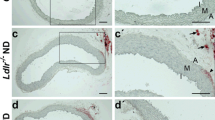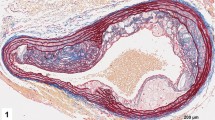Abstract
Rabbits are widely used for the study of atherosclerosis; however, the lack of a unified and quantitative analysis of atheroma limits data interpretation and comparisons between laboratories. In this study, we applied a simple quantitative method, referred to as the oil red O (ORO) dye-eluting method, for analysis of atherosclerotic plaques in freshly isolated aortas. It employs ORO staining of the plaques followed by elution of the dye that is subjected to quantitative measurement. Atherosclerosis was induced in rabbits by feeding a 1% (w/w) high cholesterol diet for 4 or 12 weeks. Thoracic aortas were isolated and sufficiently stained by ORO. These dyes were easily and completely extracted by 100% ethanol and quantified by spectrophotometric measurement at 510 nm. A series of cross-sectional slices at 100-µm intervals were counterstained by elastic van Gieson. It was found that there was a highly positive correlation between the dye concentration and the amount of plaque tissue, determined as volume of plaques (regression coefficient r2: 0.8792, p < 0.001). The color equivalence of the dye content was expressed as µg/mm2 of intimal aorta area to allow direct comparisons among aortas. The color equivalences of ORO content in rabbits fed 12 weeks were almost 5.0 times higher than those fed 4 weeks. Thus, this ORO dye-eluting method is useful for quantification of atherosclerotic plaques in aortas in rabbits, as well as other animal models.






Similar content being viewed by others
References
Fan, J., Kitajima, S., Watanabe, T., Xu, J., Zhang, J., Liu, E., & Chen, Y. E. (2015). Rabbit models for the study of human atherosclerosis: from pathophysiological mechanisms to translational medicine. Pharmacology & Therapeutics, 146, 104–119.
Steinberg, D. (2004). Thematic review series: the pathogenesis of atherosclerosis. An interpretive history of the cholesterol controversy: part I. Journal of Lipid Research, 45, 1583–1593.
Hansson, G. K., Seifert, P. S., Olsson, G., & Bondjers, G. (1991). Immunohistochemical detection of macrophages and T lymphocytes in atherosclerotic lesions of cholesterol-fed rabbits. Arteriosclerosis and Thrombosis: A Journal of Vascular Biology, 11, 745–750.
Hong, M. K., Vossoughi, J., Mintz, G. S., Kauffman, R. D., Hoyt, R. F. Jr., Cornhill, J. F., … Hoeg, J. M. (1997). Altered compliance and residual strain precede angiographically detectable early atherosclerosis in low-density lipoprotein receptor deficiency. Arteriosclerosis, Thrombosis, and Vascular Biology, 17, 2209–2217.
Wang, Y., Bai, L., Lin, Y., Chen, Y., Guan, H., Zhu, N., … Liu, E. (2015). Combined use of probucol and cilostazol with atorvastatin attenuates atherosclerosis in moderately hypercholesterolemic rabbits. Lipids in Health and Disease, 14, 82.
Bentzon, J. F., Otsuka, F., Virmani, R., & Falk, E. (2014). Mechanisms of plaque formation and rupture. Circulation Research, 114, 1852–1866.
Paigen, B., Morrow, A., Holmes, P. A., Mitchell, D., & Williams, R. A. (1987). Quantitative assessment of atherosclerotic lesions in mice. Atherosclerosis, 68, 231–240.
Lin, Y., Bai, L., Chen, Y., Zhu, N., Bai, Y., Li, Q., … Liu, E. (2015). Practical assessment of the quantification of atherosclerotic lesions in apoE(−)/(−) mice. Molecular Medicine Reports, 12, 5298–5306.
Weber, C., & Noels, H. (2011). Atherosclerosis: current pathogenesis and therapeutic options. Nature Medicine, 17, 1410–1422.
Littie, R. D. (1944). Various oil soluble dyes as fat stains in the supersaturated isopropanol technic. Stain Technology, 19, 55–58.
Zhang, C., Zheng, H., Yu, Q., Yang, P., Li, Y., Cheng, F., … Liu, E. (2010). A practical method for quantifying atherosclerotic lesions in rabbits. Journal of Comparative Pathology, 142, 122–128.
Nunnari, J. J., Zand, T., Joris, I., & Majno, G. (1989). Quantitation of oil red O staining of the aorta in hypercholesterolemic rats. Experimental and Molecular Pathology, 51, 1–8.
Beattie, J. H., Duthie, S. J., Kwun, I. S., Ha, T. Y., & Gordon, M. J. (2009). Rapid quantification of aortic lesions in apoE(−/−) mice. Journal of Vascular Research, 46, 347–352.
Rutherford, C., Martin, W., Carrier, M., Anggard, E. E., & Ferns, G. A. (1997). Endogenously elicited antibodies to platelet derived growth factor-BB and platelet cytosolic protein inhibit aortic lesion development in the cholesterol-fed rabbit. International Journal of Experimental Pathology, 78, 21–32.
Yu, Q., Li, Y., Wang, Y., Zhao, S., Yang, P., Chen, Y., Fan, J., & Liu, E. (2012). C-reactive protein levels are associated with the progression of atherosclerotic lesions in rabbits. Histology and Histopathology, 27, 529–535.
Otto, C. M., Kuusisto, J., Reichenbach, D. D., Gown, A. M., & O’Brien, K. D. (1994). Characterization of the early lesion of ‘degenerative’ valvular aortic stenosis. Histological and immunohistochemical studies. Circulation, 90, 844–853.
Xie, C., Ma, B., Wang, N., & Wan, L. (2017). Comparison of serological assessments in the diagnosis of liver fibrosis in bile duct ligation mice. Experimental Biology and Medicine, 242, 1398–1404.
Xiao, Y., Nie, X., Han, P., Fu, H., & Kang, J., Y (2016). Decreased copper concentrations but increased lysyl oxidase activity in ischemic hearts of rhesus monkeys. Metallomics: Integrated Biometal Science, 8, 973–980.
Koike, T., Kitajima, S., Yu, Y., Nishijima, K., Zhang, J., Ozaki, Y., … Fan, J. (2009). Human C-reactive protein does not promote atherosclerosis in transgenic rabbits. Circulation, 120, 2088–2094.
Gao, B., Li, L., Zhu, P., Zhang, M., Hou, L., Sun, Y., … Gu, Y. (2015). Chronic administration of methamphetamine promotes atherosclerosis formation in ApoE−/− knockout mice fed normal diet. Atherosclerosis, 243, 268–277.
Hu, J. H., Touch, P., Zhang, J., Wei, H., Liu, S., Lund, I. K., Hoyer-Hansen, G., & Dichek, D. A. (2015). Reduction of mouse atherosclerosis by urokinase inhibition or with a limited-spectrum matrix metalloproteinase inhibitor. Cardiovascular Research, 105, 372–382.
Kamkar, M., Wei, L., Gaudet, C., Bugden, M., Petryk, J., Duan, Y., … Ruddy, T. D. (2016). Evaluation of Apoptosis with 99mTc-rhAnnexin V-128 and inflammation with 18F-FDG in a low-dose irradiation model of atherosclerosis in apolipoprotein E-deficient mice. Journal of Nuclear Medicine, 57, 1784–1791.
Acknowledgements
The authors wish to acknowledge Mr. Zhenghui Luo, Ms. Jingyao Zhang, and Ms. Shan Zhao for their technical assistance.
Author information
Authors and Affiliations
Contributions
All authors participated in conceive, design, and review of the manuscript; LJZ carried out the ORO, EVG, SR, and immunohistochemistry staining. LJZ, YX, and XM analyzed the data and interpreted the results; NW performed the sequential sectioning process; LJZ wrote the draft of the manuscript and YJK edited, revised, and approved the final version of the manuscript.
Corresponding author
Ethics declarations
Conflict of interest
The authors have declared that no competing interest exists.
Rights and permissions
About this article
Cite this article
Zhao, LJ., Xiao, Y., Meng, X. et al. Application of a Simple Quantitative Assessment of Atherosclerotic Lesions in Freshly Isolated Aortas from Rabbits. Cardiovasc Toxicol 18, 537–546 (2018). https://doi.org/10.1007/s12012-018-9465-z
Published:
Issue Date:
DOI: https://doi.org/10.1007/s12012-018-9465-z




